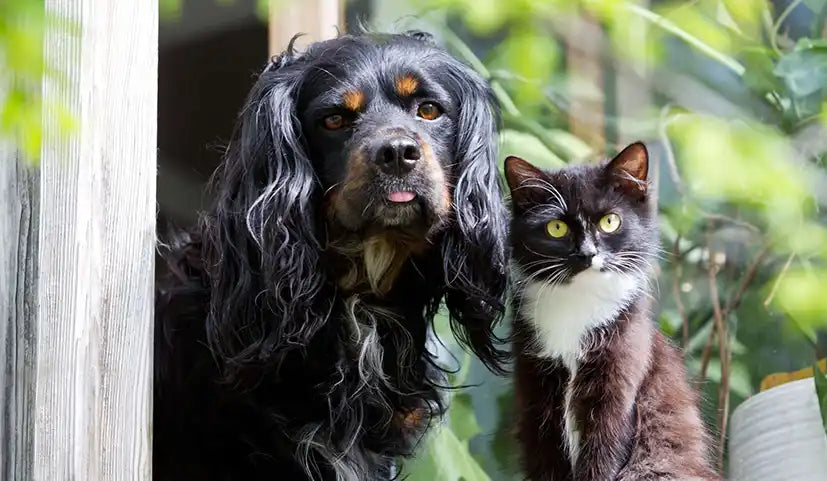Your dog’s sleep position is like a little window into how they feel, safe, anxious, chilly, warm, comfy or in discomfort.
Below, you’ll learn what each position really means (in proper pet-parent language), what’s normal, what’s not, and how to support deeper, healthier sleep with natural PetWell supplements.
Why Do Dogs Sleep in So Many Different Positions?
Dogs spend almost half their life asleep, and their sleep style is shaped by:
- how safe they feel
- their temperature
- their stress levels
- their gut health
- their joints
- their personality
Outdoor dogs or anxious dogs tend to sleep lightly. Indoor dogs who feel secure fall into deeper, restorative sleep.
Understanding why your dog chooses a position helps you support their emotional and physical wellbeing.
Dog Sleep Positions and What They Mean
Below are the most common sleeping positions, the ones pet parents search for the most.
1. Why Does My Dog Sleep Curled Up in a Ball?
Also called The Curl-Up, this nose-to-tail position is pure instinct.

Dogs curl up to:
- protect their vital organs
- stay warm
- feel more secure
- spring up quickly if needed
Dogs may curl up more when they’re:
- cold
- adjusting to change
- feeling anxious
Anxiety support: PetWell CALM (powder or CALM + TURKEY treats) helps dogs relax instead of staying “on alert.”
2. What Does the Superman Position Mean?
This is the flat-on-the-belly, legs-out pose, basically a furry superhero.

It usually means:
- they’re lightly napping
- they’re ready to jump up and play
- they’re cooling their belly on a cool surface
Common in puppies, working dogs and high-energy dogs.
3. Is Side Sleeping a Good Position for Dogs?
Yes, one of the very best.

Side sleeping helps dogs:
- relax fully
- fall into deep sleep
- stretch joints comfortably
It’s also a big “I trust you” sign, their organs are completely exposed.
If your dog avoids this position: They may be stiff or sore. PetWell MOBILITY can support comfortable rest. Read more about Signs of Joint Pain in Dogs
4. Why Do Dogs Sleep Belly-Up with Paws in the Air?
This is the “I’m safe, I’m comfy, don’t bother me” position.

Dogs choose this when they’re:
- relaxed
- confident
- cooling down (heat escapes from the belly and paws)
- feeling totally secure at home
Few things scream “happy dog” louder than this.
5. What Is the Lion’s Pose and Why Do Dogs Use It?
This is when your dog rests their head on their paws, front legs tucked, body ready to move.

Dogs choose this when they:
- want to stay alert
- are lightly resting, not deeply asleep
- feel they may need to react quickly
Often seen in anxious or vigilant dogs. If you think your dog suffers with stress and anxiety. This article could be useful: What is Dog Anxiety: Causes, Symptoms & Solutions
6. Why Does My Dog Sleep Against Me or Another Pet?
This is The Cuddler, and it’s adorable.

Dogs cuddle because they:
- love you
- feel safer close to you
- seek warmth
- want bonding time
- may have mild separation anxiety
Cuddling boosts oxytocin in both of you, the “feel-good” hormone.
If anxiety is part of it: PetWell CALM can gently support emotional balance.
7. Why Does My Dog Burrow Under Blankets?

Dogs who slide under blankets, clothes or pillows are usually:
- seeking warmth
- craving safety
- self-soothing
- looking for a den-like environment
Very common in anxious dogs or breeds that like enclosed spaces.
Dog Sleep Behaviours Explained
In addition to these dog sleep positions, you may have noticed some behaviours such as odd body movements and sounds whilst they sleep. These behaviours can tell you a lot about the quality of your dog’s sleep.
Why Does My Dog Bark or Whine in Their Sleep?
They’re dreaming. Completely normal.
Why Do Dogs Circle Before Lying Down?
It’s instinct. Wolves circled to create a comfy little nest.
Do Dogs Really Dream?
Yes, research suggests they dream about daily events, experiences and interactions.
Why Does My Dog “Run” in Their Sleep?
Those tiny leg kicks are dream responses, totally harmless and very cute.
Is It Normal for Dogs to Snore?
Yes, especially flat-faced breeds. But new snoring can signal allergies.
PetWell RELIEF supports immune health, skin/coat balance and inflammation, often helping reduce allergy-related snoring.
Why Does My Dog Twitch in Their Sleep?
Twitching happens as dogs shift between sleep stages. Normal unless extreme.
How Much Sleep Does a Dog Need?
Puppies - 18–20 hours (growing is exhausting).
Adult Dogs - 10–12 hours (giant breeds may sleep even more).
Senior Dogs - Up to 20 hours (their bodies tire faster).
Working breeds, Kelpies, Cattle Dogs, Border Collies, may sleep less because they’re naturally high-energy.
How to Help Your Dog Sleep Better
Try simple changes like:
- giving belly-up sleepers a cool area
- giving curlers more blankets
- creating predictable routines
- supporting gut health (poor gut balance can disrupt sleep)
- supporting joints in older or stiff dogs
- reducing anxiety before bedtime
PetWell sleep-supporting options:
- CALM → great for stressed, anxious or restless dogs
- DIGEST → supports gut balance (70% of immunity + mood hormones originate in the gut)
- MOBILITY → supports comfortable rest for older or stiff dogs
All natural. Human grade ingredients. Animal naturopath formulated. Vet reviewed. Made in Australia.
When Should I Worry About My Dog’s Sleeping Position?
Speak with your vet if your dog shows:
- a sudden change in sleeping style
- restlessness or difficulty settling
- new signs of stiffness
- new or heavy snoring
- signs of pain when lying down
- sleep paired with anxiety or pacing
Sleep changes often reveal discomfort long before daytime behaviour does.
Final Thoughts
Your dog’s sleep style tells a beautiful story about how they feel, safe, connected, nervous, warm, cold or uncomfortable. When you understand what each position means, you can support their emotional wellbeing, physical health and overall comfort.
And when you want natural support for gut health, anxiety, joints or skin, PetWell’s all-natural human-grade ingredient supplements have your back (and your dog’s belly… and dreams).
Disclaimer: The entire contents of PetWell emails and website are not to be taken as medical advice. The team at Pet Squad Pty Ltd trading as PetWell encourages you to make your own pet health care decisions based on your research and in partnership with a qualified pet healthcare professional.
This article was prepared by the team at PetWell. Australia’s trusted provider of natural, human-grade pet supplements and freeze-dried treats for dogs and cats. Drawing on holistic animal behaviour insights and years of working with canine clients, PetWell champions kind, calm and scientifically informed solutions for every pet parent.
Posted By Ayda Hornak - Trained in Canine Psychology and Natural Animal Nutrition Care.









































